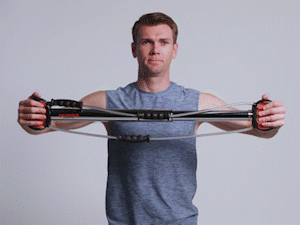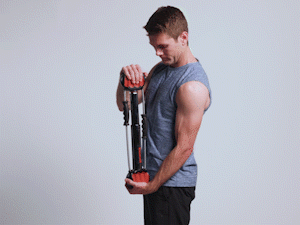Isometric and isotonic exercises are critical to a good workout routine. Both types of exercises work in tandem to create great results.
Isometrics are exercises that focus on movements without contracting one’s muscles. Static holds and force exerted on objects with a greater resistance are examples of isometrics.
Isotonics on the other hand, are movements that revolve around normal contractions of muscles. So, curls and lifts, where you are consistently moving a muscle in and out of a stationary position are key.
A real-world example of isometric vs. isotonic exercises is the difference between holding two heavy grocery bags in your hands and pulling the grocery bags up and down with your arms respectively. One method creates tension and the other constant contractions.
The intention is how to get the most out of isometric and isotonic movements. A couple of examples of isotonic exercises include aerobics, swimming, and hiking among others. As for isometric exercise examples, many of your favorite stretches and exercises are traditionally isometric focused, like wall pushes and planks. There are endless benefits to both movements (or lack thereof). So, with such a great variety of benefits to choose from, how do you go about choosing what to incorporate into your fitness regimen?
That’s a tricky question, for a number of reasons, but let’s walk through the benefits of both to understand how they can work in your own regimen.

Benefits of Isometrics
Lower Blood Pressure
Isometric workouts have been scientifically proven to show a help in reducing blood pressure. Maintaining proper blood pressure is known to lower the risk of stroke, kidney disease, and heart disease. A normal blood pressure level is less than 120/80 mmHg. To help achieve healthy blood pressure levels, incorporate daily isometric holds while focusing on the strength of your grip.
Improved Mobility and Flexibility
Mobility and flexibility are improved through isometrics. The use of a full range of motion and the tension utilized in these exercises helps. As the muscles are not contracting, this allows them to lengthen and attempt to overcome resistance.
Strength Building
The most prominent benefit of isometrics is the ability to build strength more efficiently than standard weightlifting techniques. In fact, isometrics do so about 60% faster than regular weight training. This fact is based on a 10-year-long study conducted that examined the correlation between both weightlifting and isometric exercises.
Efficacy
Increased speed of gaining strength means exercises are more efficient. Isometric exercises take less time to see comparable results to that of traditional weightlifting.
Muscle and Injury Rehabilitation
Isometrics are low impact. Because of this, they aid in strength and muscle growth as well as muscle recovery.
In addition to all of the aforementioned benefits, there’s plenty more such as:
- improved bone density
- lower cholesterol levels
- better digestive functions.
5 Benefits to Isometric Strength Training: Isometric Exercises Made Easy
Benefits of Isotonics
Boosts Cardiovascular Health
Increased oxygen consumption accompanies isotonic movements. With more oxygen, the better it is for your cardiovascular system. A healthy cardiovascular system also reduces the risk of heart attack, helps to maintain healthy body weight, and in turn, lowers one’s blood pressure.
Burn Calories
Isotonic exercises are the ones that really make you sweat. With a good pump and sweat, you are effectively burning calories allowing you to drop more pounds. The increase of repetitions (multiple isotonic movements) furthers that cardiovascular exercise potential.
Strengthens Joints and Increases Flexibility
With consideration toward the motions that are included in isotonic exercises, the result is strengthened joints and increased flexibility. The use of a full range of motion furthers this benefit.
In addition to these benefits, one can also:
- Increase bone density
- Improve muscular endurance
- Add mass
- Increase strength
- Reduce body fat
Which Exercise is Best For You?
Isometrics and isotonic exercises are beneficial. By combining both forms of exercise, you get the best of both worlds. For example, if you look at the example of the grocery bag, an isometric hold with the addition of isotonic repetitions at the end of the hold is how you capitalize on the benefits of both. In fact, combining both makes your workouts even more efficient as they are training muscles differently. You are also more thorough, hitting contractions and tension simultaneously. Why work out harder when you can work out smarter?
Not to toot our own horn (toot, toot), but combining isometric and isotonic repetitions is what the Bullworker line of products was designed to do. From the Bullworker Bow Classic to the portable and quick Iso-Bow, all Bullworker products are built for isometric and isotonic exercise. How does that look? Well, we assembled a couple of example movements and exercises below to give you an idea of how isometrics and isotonics can be used together.
Exercise Examples
Chest Compression w/ Bow Classic or Steel Bow

For this exercise, you will begin the movement with both hands on their corresponding handle. You will then compress the unit together, hold and feel the tension for 7 seconds. You should feel it in your chest, shoulders, and core. You will then release and proceed to compress your Bullworker together at steady intervals for 12 repetitions.
Bicep Curls (using Bow Classic or Steel Bow)
In this exercise, you will hold your Bullworker in a vertical position. Grip the bottom handle, closest to the floor, with your palm facing up and the top handle, facing the ceiling, you will grip with your palm facing down. Starting in this position, you will curl your bottom arm upwards bending only at your elbow while pushing back on with your top hand. This action will cause tension that you will hold for 7 seconds. From that point, release and curl the upper arm while maintaining tension for controlled repetitions.
These are only a couple of examples. The number of options is truly endless. Not to mention, this equipment can be combined with other exercises to diversify your routine. Wall sits and pushes, as well as bodyweight push-ups and sit-ups are examples of isometric and isotonic exercises that can be added to a workout easily. The biggest thing is to approach isometrics and isotonic movement with a plan. This way, you can minimize time and maximize your results.
Conclusion
Isometric strength training and isometric exercise techniques both have a plethora of benefits. So lucky you, you do not have to choose between one or the other. In fact, isometrics and isotonic exercises compliment each other very well during the same workout or you can even mix up your training week.
We hope you enjoyed this post and please keep us updated with your fitness progress, Let us know your thoughts e sure to share with your friends and family.






